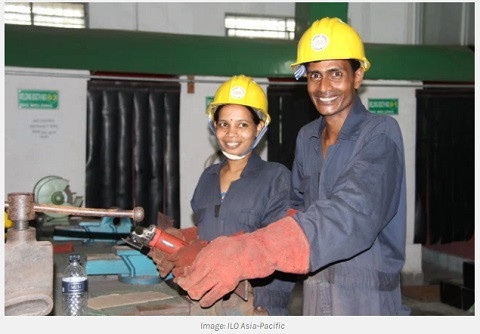
GCED Basic Search Form
Quick Search
You are here
News

By Paul Comyn, ILO
With less than 5 months since the first official reporting of a Coronavirus (COVID-19) case, we have almost arrived at a global paralysis of regular education and training provision. This unprecedented situation is affecting learning at all levels but especially initial and continuing TVET, adult education and work-based learning, which have come to a stop as we know them. The situation has upturned course schedules and attendance, disrupted teaching and learning, frustrated examinations and assessments, delayed certification and will likely affect the immediate and future careers of millions of learners. But TVET and skills programs do not easily migrate to distance and online learning.
Despite these challenges, in some contexts, it is clear that the crisis also provides an opportunity for the development of more flexible learning solutions that make better use of distance learning and digital tools. However, the shift to online or distance learning in TVET and skills development during the pandemic should be seen first and foremost as an emergency response and not a rapid and permanent migration of programs. Short term solutions can be and have been found but we must seize this opportunity to create long-term positive impacts and develop greater resilience.
Mobilising human and financial resources during this crisis is fundamental to ensure universal access to digital tools and modern learning technologies in the TVET and skills sector. The training of teachers and instructors, managers and learners to ensure their readiness to engage in digital learning must be addressed, and education and training providers have to revise teaching and learning models to make the best use of digital resources and tools.
As of April 14, 2020, according to UNESCO, nearly 1.6 billion or 91.3% of school students have been affected by system closures in 188 countries. Other countries have also implemented localized closures affecting millions of additional learners. Whilst these figures may capture TVET students enrolled in secondary education systems, comprehensive international data on the impact on TVET students is not yet available. In the Latin America and Caribbean region however, we know from ILO CINTEFOR that 85% of TVET institutions are completely closed.
In the TVET and skills sector, there is evidence that the major challenge for institutions has been to remain operational, to establish and maintain communications with and between teachers and students, and to continue to provide their services to the community, despite having suspended face-to-face classes.
An additional challenge to TVET institutions trying to remain operational is that some are also supporting national crisis response measures. For example, in the Philippines and Costa Rica they are using their workshops to manufacture personal protective equipment and hand sanitizer for healthcare personnel, or to 3D print medical devices.
In addition to the closure of colleges, work-based learning is being maintained in very few countries and in sectors like finance and ICT where commercial activities continue through teleworking. This element of TVET programmes is the most affected by the pandemic, and its impact is highest in countries where it is a compulsory part of the curricula.
Despite recent advances in technology, distance learning, be it online or offline, is not a long-term substitute for face-to-face teaching and practical skills training. In low- and middle-income countries, there are many issues impeding the wider and permanent diffusion of distance learning. These involve socio-economic and cultural aspects beside the limited ICT infrastructure that contributes to the digital divide. While new solutions for teaching and learning could bring much needed innovation to education and training systems, the shifts we are seeing have the potential to exacerbate existing inequalities for those who already face disadvantages in trying to access and engage in learning.
We cannot ignore the digital divide and the uneven access to equipment, tools and skills it implies and we cannot allow the rush to go online to widen existing inequalities. We need to recognise the significant challenges that distance and online learning presents for teachers and trainers, working in institutions and systems that are underfunded and neglected compared to general and university education. If we want to ensure that the shift to distance and online learning both meets immediate learning needs and prepares us for more effective TVET and skill systems in the future, a number of key measures need to be taken now and in the months ahead. Decision makers need to:
- improve internet infrastructure and access to the internet;
- expand access for learners to online digital application and platforms;
- utilise inclusive digital and analogue technologies for distance learning and support lo learners;
- support teachers and trainers to operate in the new environment;
- provide support, career guidance and digital skills development for learners;
- increase distance and short course learning options for core, entrepreneurial and employability skills to vulnerable groups and individuals;
- strengthen systems for the recognition and validation of digital learning;
- increase investment in digital solutions for practical skills development; and
- improve social dialogue and coordination amongst education and training institutions, employment services and local authorities.
URL:
